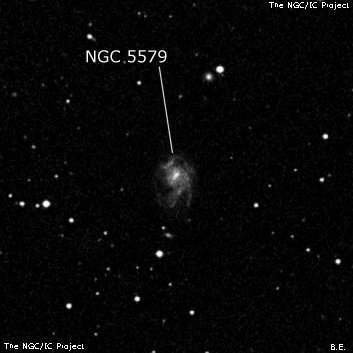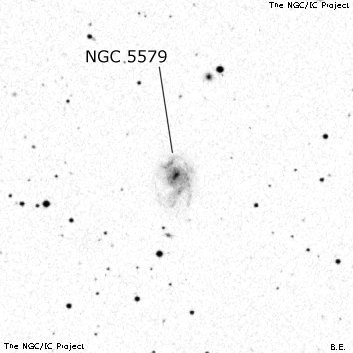NGC/IC Project Restoration Effort
(This is a very very beta version)
NGC5579


Basic Information
Location and Magnitude
Right Ascension: 14:20:26.4
Declination: +35:11:21
Constellation: BOO
Visual Magnitude: 13.6
Historic Information
Discoverer: Herschel W.
Year of discovery: 1785
Discovery aperture: 18.7
Observational
Summary description: vF, cL, p of 2
Sub-type: Sc
Corwin's Notes
=====
NGC 5579 and NGC 5580. N5579 was first seen by WH who described it as simply
"eF, pL." JH saw it twice, first in April 1827, and again in March 1831.
N5580 was picked up by him only on the first occasion. Here are his data:
NGC H h/Sweep RA (1950) Dec Desc
5579 III.415 1784/72 14 18 21.1 +35 25 08 F, pL, the preceding of 2
" " " /331 18.4 47 eF, L, 30 or 40''.
5580 --- 1785/72 14 18 33.5 +35 26 13 Not vF; 20''; the following of 2
There five other NGC objects in the area, all but one seen or discovered by WH
and/or JH. The Herschels' data (all precessed to 1950.0)
5567 --- 1780/337 14 17 09.6 +35 21 03 pF, R
5588 --- 1789/28 14 19 18.8 +35 21 11 eF
5589 III.416 1788/71 14 19 18.9 +35 30 13 vF, S, R
" " " /337 14 19 18.2 +35 29 37 The np of 2. Pos with other =
330.0 deg by micrometer.
5590 III.417 1791/28 14 19 31.5 +35 26 12 vF, a stellar nucleus
" " " /71 14 19 32.0 +35 25 54 pF, R, 20''
" " " /337 14 19 29.8 +35 25 31 pB, R, psbM; 15''; the sf of 2.
Moon above horizon.
The other object was found by Bigourdan:
5568 = Big. 72 14 17 14.2 +35 19 18 vF, S, v dif
There is little question about the identities of NGC 5567, 5568, 5579, 5589,
and 5590. The GSC positions (B1950.0) are
5567 14 17 10.63 +35 22 01.7
5568 14 17 14.27 +35 19 16.9
5579 14 18 19.82 +35 25 00.2
5589 14 19 18.63 +35 29 54.1
5590 14 19 31.84 +35 25 56.5
However, as Glen Deen points out -- that's it. Nothing else in the area
except stars and very faint galaxies that the visual observers would not have
seen. The only other observations in the area before the NGC were by Lord
Rosse; he and/or his observer looked twice for N5588, 5589, and 5590, and saw
only two nebulae in the area both times. In spite of JH's rather emphatic
statement in the GC notes, there are indeed only those two near JH's three
positions.
Looking at all of this, I noticed some peculiarities in the positions,
descriptions, and sweeps.
1) First, N5580 was seen only during one sweep, and exactly precedes
N5590 by one minute of time (the declinations are the same to
within JH's usual standard deviation -- 2 arcmin give or take).
2) The description for N5580 is consistent with its being N5590.
It also follows N5579 by the same amount that N5590 follows
N5589, and is noted as the following of two.
3) Neither N5589 or N5590 were seen on the two sweeps when N5579
and N5580 were seen -- nor were N5579/80 seen on any of the
sweeps when the others were seen. N5590 is also the brightest
of the five objects, and is therefore the most likely to be seen
during a sweep.
So, I'm going to suggest that N5580 is actually N5590. This is not certain,
of course, because N5579 is noted as the preceding of two in the same sweep in
which N5580 was noted as the following of two. This would suggest that N5579
and N5589 are also identical -- but the positions and descriptions of those
two fit very well with what we know is in the sky. Nevertheless, the idea
that N5580 = N5590 is a plausible one, so I'll throw it out for discussion,
with colons, of course.
Steve's Notes
=====
NGC 5579
13.1" (4/10/86): faint, fairly large, slightly elongated, very diffuse, even surface brightness. NGC 5590 lies 15' E and the NGC 5567/5568 pair is 15' WSW.



